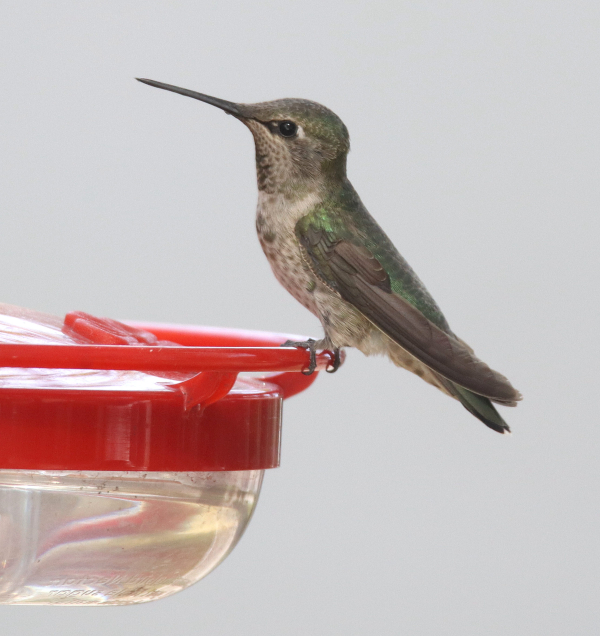
A clean feeder filled with a fresh 1-to-4 sugar-to-water ratio is all it really takes to attract hummingbirds (Ruby-throated Hummingbird photo by Paul Konrad).

This is an oversized illustration of an ant moat, which you fill with water and install above the feeder hanger to keep crawling bugs from accessing the feeder.
|
As indicated by the number of hummingbird-related birding festivals across America, starting in late July and continuing into September, the post-nesting period of hummingbirds is an exciting time for birders at our feeding stations and flower gardens. And there may be as many as twice as many hummingbirds migrating south considering the addition of recent fledglings. During August, hummingbirds are more likely to spend some extra time in our yards when they aren’t in such a rush to move on. In fact, increased hummer activities might suggest the addition of an extra feeder, especially as individuals become territorial over your dependable nectar source.
It's exciting that now our feeders and flower gardens are becoming focal points as we provide food, cover, water, and resting areas for hummingbirds in our yard. Attracting hummingbirds is easy as long as you live within the range of at least 1 of the 9 hummingbird species found north of Mexico during the warm season. First, be sure your hummingbird feeder is always filled with fresh sugar-water nectar.
Making sugar-water nectar is easy: Just mix 1 part sugar with 4 parts water. Use white cane sugar and fresh water to make hummingbird nectar, using a measuring glass or another option to measure the simple ingredients. We find that using a shot glass to measure is even easier than using a measuring cup. Why the 1 to 4 ratio? Because it best resembles the sugar content found in the best nectar-producing flowers that hummingbirds feed at.
Keeping your feeder clean is important too. We soak our feeder in boiling hot water a few minutes, then scrub it with a toothbrush, rinse it thoroughly, then soak it in boiling hot water again to kill and prevent any black mold or any other potential hummingbird health hazard.
Then fill your feeder with your new mix of sugar-water, hang you feeder, and you are good for a while – enjoy the hummingbird action, and don’t hesitate to give them a closer look with binoculars. We like to use an “ant moat” to keep small crawling insects off the feeder, which is simply a specially built cup you can attach to your feeder’s hanger. When filled with water, it will prevent bugs on foot from accessing the hanging feeder. Some feeders even have a built-in ant moat, so it’s worth checking for an ant moat on any new nectar feeders you are considering.
Then too, hummingbirds don’t live by nectar alone – they are active hunters that search for and feed on tiny insects and spiders every day – they need protein too. It’s interesting to watch a hummingbird flying from plant to plant, flower to flower; but keep in mind that the hummer might be feeding on tiny bugs hidden among the flowers and vegetation. They will even look for little bugs around your feeding station before perching for a sip of nectar, and they will rob little spider webs too.
Speaking of flowers, you can easily add a few fresh flowering plants from a local greenhouse, garden store, or hardware store. A rule of thumb for selecting preferred hummingbird flowers is to pick out red tubular-shaped flowers, such as flowering red salvia, red cardinal flower, bee balm, red trumpet vines, honeysuckle, lupine, and more. Add them to an existing garden or transplant them into a larger “hummingbird flower pot” that you can position anywhere in your yard that gets some sunshine. You can even spruce up your feeding station with a hummingbird flower pot or two.
Overall, your interest and efforts in providing hummingbird resources is especially important to supplement the other food and landscaping hummers utilize. But attracting hummingbirds can also important for your personal well-being, your sense of happiness, wonder, and your connection with nature. And that extends to your family members and visitors who enjoy seeing these tiny fast-flying ambassadors of nature at a feeder right outside a window and in your flower gardens.
When you are interested in learning more about 1 or all of the 9 species of hummingbirds found north of the border, refer to All About Birds at Online bird guide, bird ID help, life history, bird sounds from Cornell | All About Birds Simply type “hummingbird” into the Enter Species box, and a list with the names of all North American hummingbird species will appear, allowing you to choose the species you want to learn more about. A favorite illustration provided for each species is the range map that provides a look at a species’ nesting range, its wintering range, and the primary migration route between the two. Actually, many of our nesting hummingbird species winter just south of the border in portions of Mexico. You can also learn more about the 9 hummingbird species you are most likely see north of Mexico at 9 Hummingbird Species to Look Out for This Summer | All About Birds All About Birds
Share your backyard birding experiences and photographs with The Birding Wire at editorstbw2@gmail.com